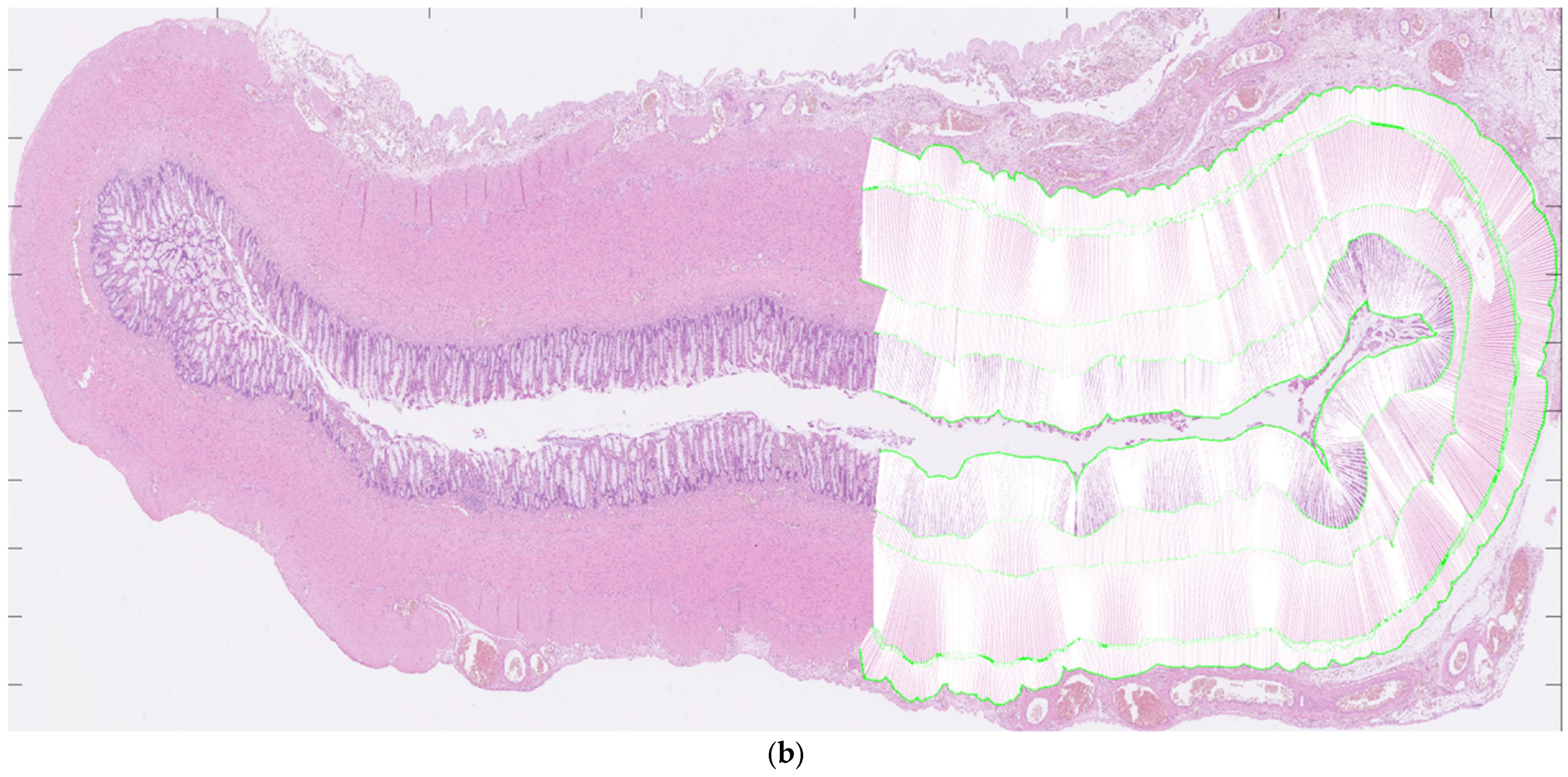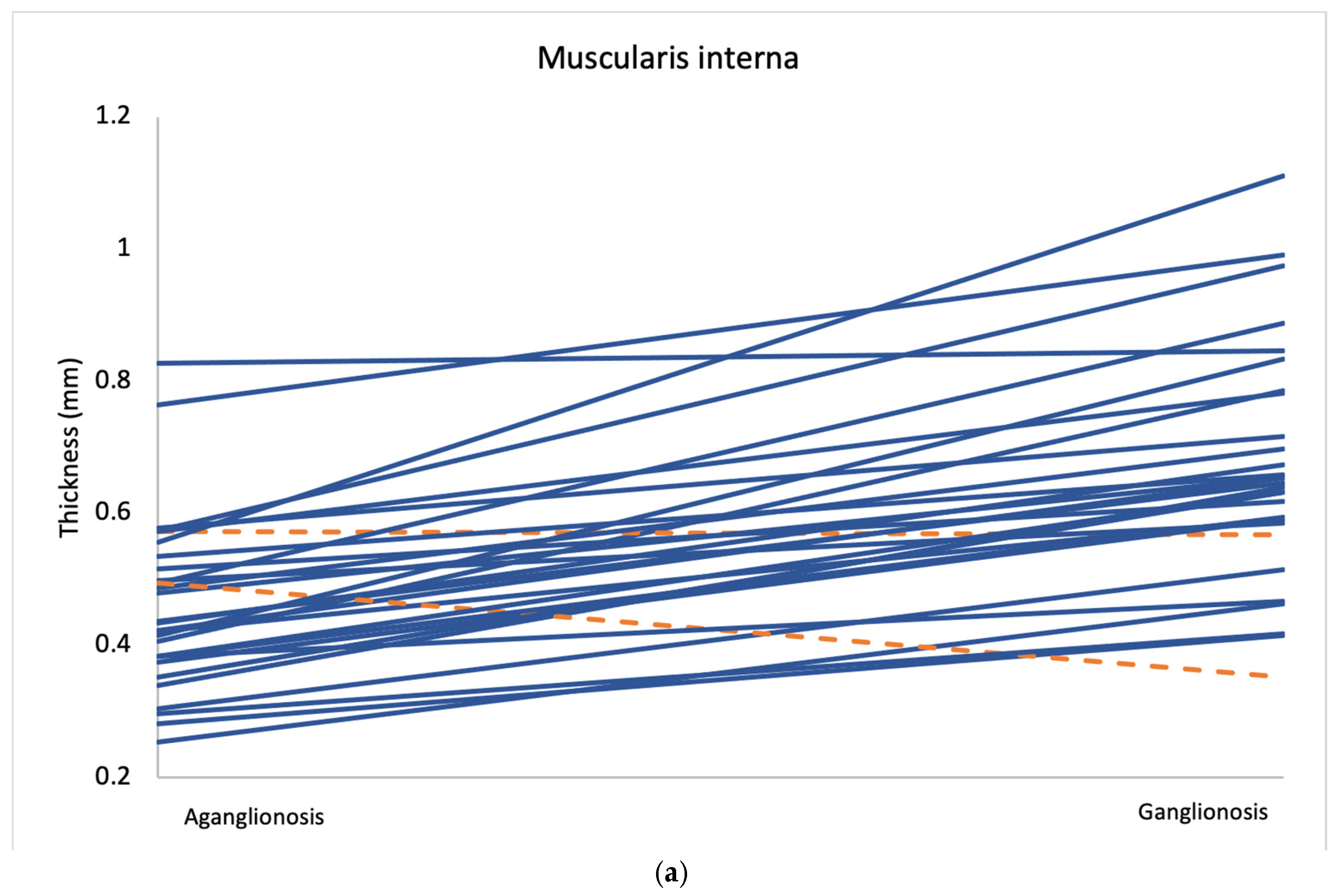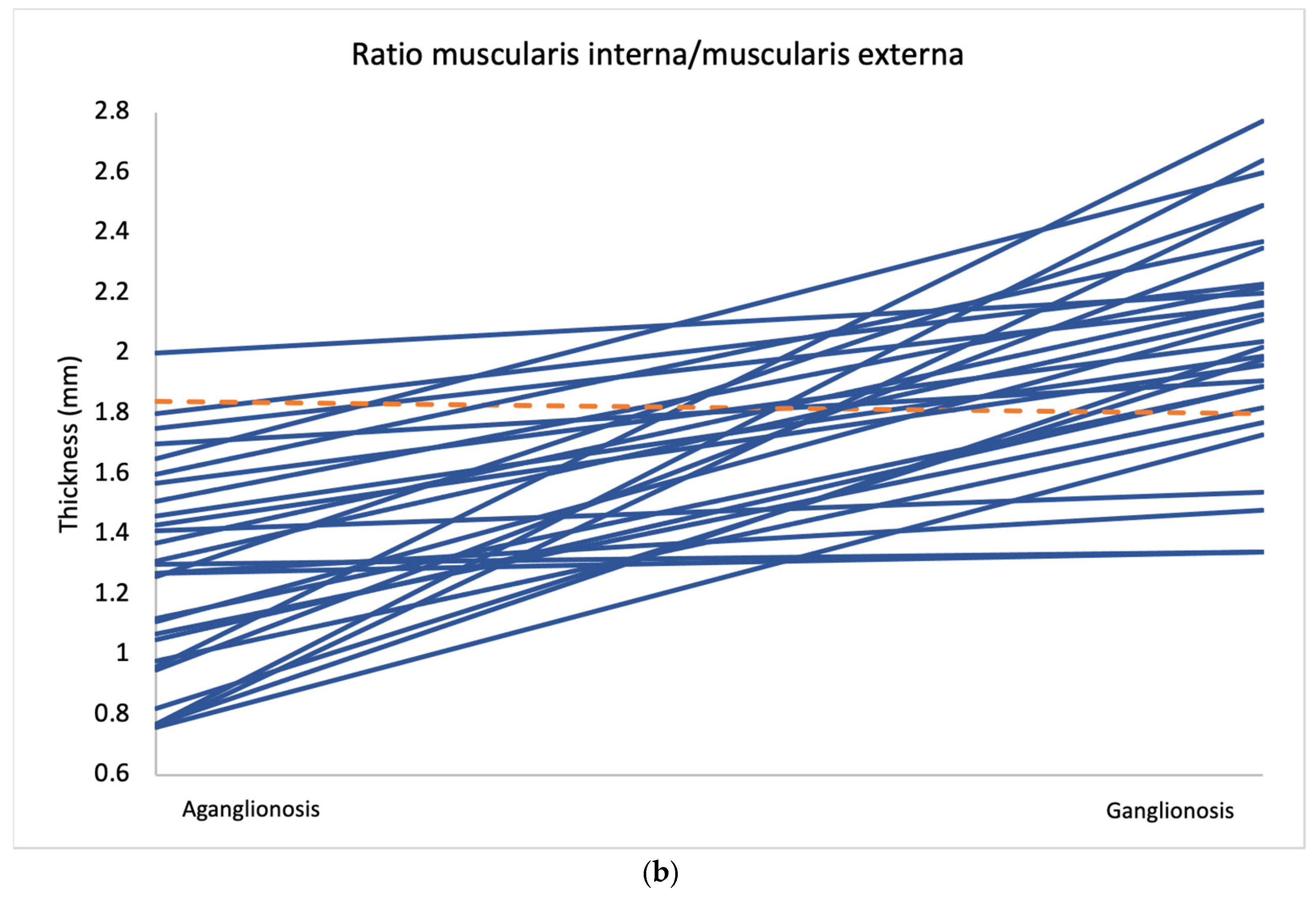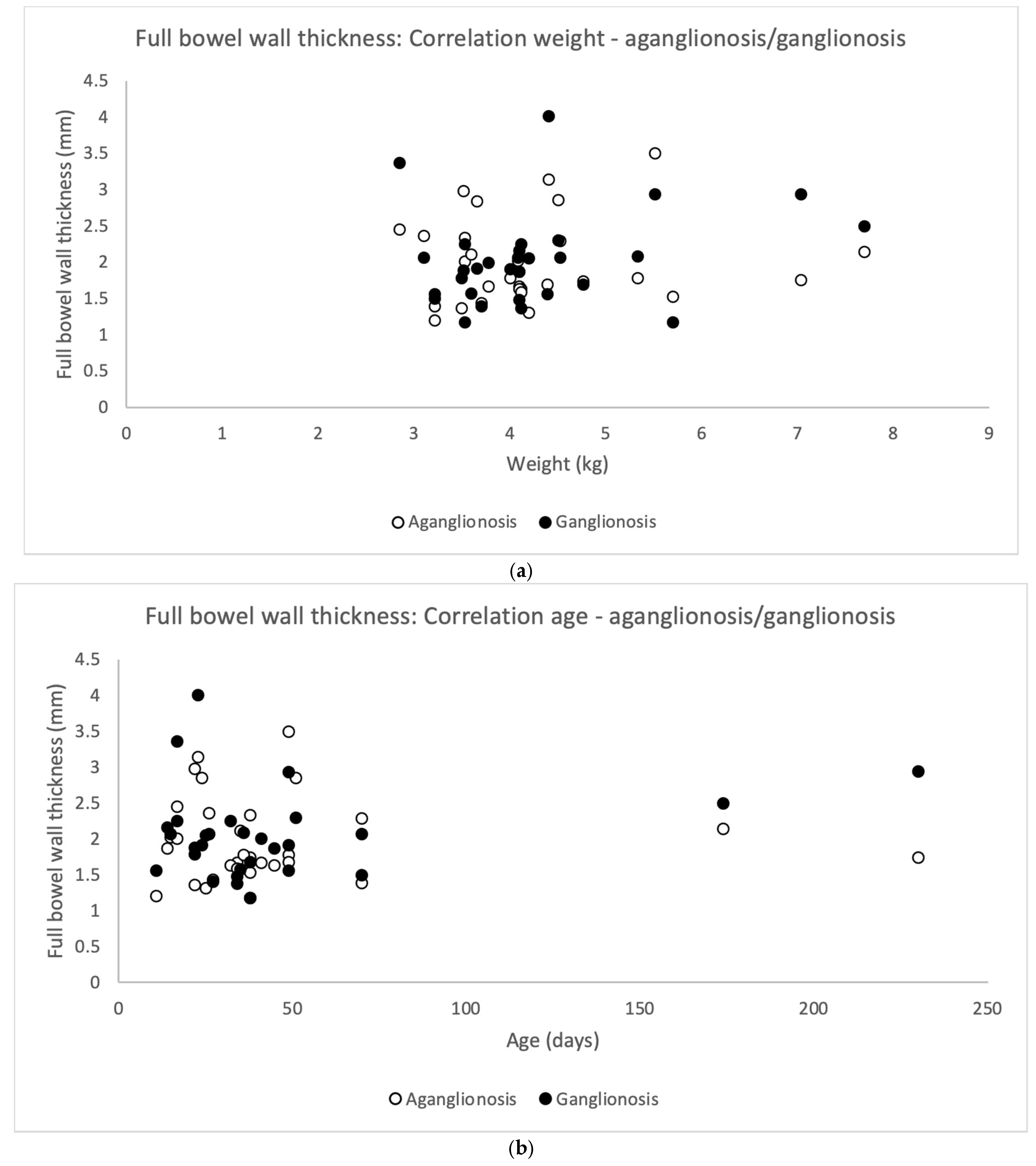Histoanatomic Features Distinguishing Aganglionosis in Hirschsprung’s Disease: Toward a Diagnostic Algorithm
Abstract
1. Introduction
2. Methods
2.1. Patients and Data
2.2. Specimen Treatment and Histopathological Analysis
2.3. Morphometrical Methods: Histological Layers
2.4. Statistical Analysis
2.5. Ethical Considerations
3. Results
3.1. Patients
3.2. Histological Layers of Bowel Wall
3.3. Diagnostic Algorithm
- (I).
- Thinner muscularis interna in aganglionic compared to ganglionic bowel,
- (II).
- Lower muscularis interna/muscularis externa ratio in aganglionic bowel.
3.4. Correlation to Age and Weight
4. Discussion
5. Conclusions
Author Contributions
Funding
Institutional Review Board Statement
Informed Consent Statement
Data Availability Statement
Acknowledgments
Conflicts of Interest
Abbreviations
| HD | Hirschsprung’s disease |
| LIMS | Laboratory Information Management System |
Appendix A
| Histoanatomical Layer | Thickness Aganglionosis Mean (SD) | Thickness Ganglionosis Mean (SD) | Difference Mean (SD) | Confidence Interval of the Difference | p-Value * | Thicker/Greater in Ganglionosis Versus Aganglionosis (n) |
|---|---|---|---|---|---|---|
| Muscularis externa (mm) | 0.261 (0.092) | 0.203 (0.079) | 0.058 (0.094) | −0.041–0.157 | 0.190 | 2 |
| Muscularis interna (mm) | 0.316 (0.057) | 0.436 (0.173) | −0.120 (0.126) | −0.252–0.012 | 0.066 | 5 |
| Ratio m. interna/m. externa | 1.321 (0.446) | 2.200 (0.322) | −0.880 (0.576) | −1.484–(−0.275) | 0.013 | 6 |
| Myenteric tissue layer (mm) | 0.009 (0.009) | 0.010 (0.010) | −0.001 (0.009) | −0.010–0.008 | 0.742 | 4 |
| Submucosa (mm) | 0.418 (0.149) | 0.508 (0.140) | −0.090 (0.145) | −0.242–0.062 | 0.189 | 3 |
| Mucosa (mm) | 0.415 (0.116) | 0.451 (0.159) | −0.036 (0.111) | −0.152–0.081 | 0.469 | 4 |
| Full bowel (mm) | 1.419 (0.189) | 1.608 (0.402) | −0.189 (0.369) | −0.577–0.199 | 0.266 | 4 |
| Ratio submucosa inner/outer length (folding) | 1.205 (0.253) | 1.186 (0.266) | 0.019 (0.274) | −0.268–0.306 | 0.872 | 4 |
References
- Burns, A.J.; Thapar, N. Advances in ontogeny of the enteric nervous system. Neurogastroenterol. Motil. 2006, 18, 876–887. [Google Scholar] [CrossRef] [PubMed]
- Thakkar, H.S.; Blackburn, S.; Curry, J.; De Coppi, P.; Giuliani, S.; Sebire, N.; Cross, K. Variability in the transition zone length in hirschsprung disease. J. Pediatr. Surg. 2020, 55, 1980. [Google Scholar] [CrossRef] [PubMed]
- Kyrklund, K.; Sloots, C.E.J.; de Blaauw, I.; Bjornland, K.; Rolle, U.; Cavalieri, D.; Francalanci, P.; Fusaro, F.; Lemli, A.; Schwarzer, N.; et al. ERNICA guidelines for the management of rectosigmoid Hirschsprung’s disease. Orphanet J. Rare Dis. 2020, 15, 164. [Google Scholar] [CrossRef] [PubMed]
- Davidson, A.J.; Sun, L.S. Clinical Evidence for Any Effect of Anesthesia on the Developing Brain. Anesthesiology 2018, 128, 840–853. [Google Scholar] [CrossRef] [PubMed]
- Shayan, K.; Smith, C.; Langer, J.C. Reliability of intraoperative frozen sections in the management of Hirschsprung’s disease. J. Pediatr. Surg. 2004, 39, 1345–1348. [Google Scholar] [CrossRef] [PubMed]
- Graneli, C.; Patarroyo, S.; Mitev, R.M.; Gisselsson, D.; Gottberg, E.; Erlov, T.; Jansson, T.; Hagelsteen, K.; Cinthio, M.; Stenstrom, P. Histopathological dimensions differ between aganglionic and ganglionic bowel wall in children with Hirschsprung’s disease. BMC Pediatr. 2022, 22, 723. [Google Scholar] [CrossRef] [PubMed]
- Erlov, T.; Hawez, T.; Graneli, C.; Evertsson, M.; Jansson, T.; Stenstrom, P.; Cinthio, M. A Computer Program for Assessing Histoanatomical Morphometrics in Ultra-High-Frequency Ultrasound Images of the Bowel Wall in Children: Development and Inter-Observer Variability. Diagnostics 2023, 13, 2759. [Google Scholar] [CrossRef] [PubMed]
- Hawez, T.; Graneli, C.; Erlov, T.; Gottberg, E.; Munoz Mitev, R.; Hagelsteen, K.; Evertsson, M.; Jansson, T.; Cinthio, M.; Stenstrom, P. Ultra-High Frequency Ultrasound Imaging of Bowel Wall in Hirschsprung’s Disease-Correlation and Agreement Analyses of Histoanatomy. Diagnostics 2023, 13, 1388. [Google Scholar] [CrossRef] [PubMed]
- Hillemeier, C.; Biancani, P. Mechanical properties of obstructed colon in a Hirschsprung’s model. Gastroenterology 1990, 99, 995–1000. [Google Scholar] [CrossRef] [PubMed]
- Wagner, J.P.; Sullins, V.F.; Khalil, H.A.; Dunn, J.C. A durable model of Hirschsprung’s colon. J. Pediatr. Surg. 2014, 49, 1804–1808. [Google Scholar] [CrossRef] [PubMed]
- Wagner, J.P.; Sullins, V.F.; Dunn, J.C. A novel in vivo model of permanent intestinal aganglionosis. J. Surg. Res. 2014, 192, 27–33. [Google Scholar] [CrossRef] [PubMed]
- Izzetti, R.; Nisi, M. Imaging the Micron: New Directions in Diagnosis with Ultra-High-Frequency Ultrasound. Diagnostics 2024, 14, 735. [Google Scholar] [CrossRef] [PubMed]
- Izzetti, R.; Vitali, S.; Aringhieri, G.; Nisi, M.; Oranges, T.; Dini, V.; Ferro, F.; Baldini, C.; Romanelli, M.; Caramella, D.; et al. Ultra-High Frequency Ultrasound, A Promising Diagnostic Technique: Review of the Literature and Single-Center Experience. Can. Assoc. Radiol. J. 2021, 72, 418–431. [Google Scholar] [CrossRef] [PubMed]
- Hawez, T.; Evertsson, M.; Erlov, T.; Hagelsteen, K.; Tofft, L.; Jansson, T.; Cinthio, M.; Graneli, C.; Stenstrom, P. The use of ultra-high frequency ultrasound in identifying aganglionosis in Hirschsprung’s disease. Sci. Rep. 2025, 15, 15124. [Google Scholar] [CrossRef]
- Graneli, C.; Erlov, T.; Mitev, R.M.; Kasselaki, I.; Hagelsteen, K.; Gisselsson, D.; Jansson, T.; Cinthio, M.; Stenstrom, P. Ultra high frequency ultrasonography to distinguish ganglionic from aganglionic bowel wall in Hirschsprung disease: A first report. J. Pediatr. Surg. 2021, 56, 2281–2285. [Google Scholar] [CrossRef] [PubMed]
- Jacobsen, R.B.; Hebelka, H.; Gatzinsky, V.; Elfvin, A.; Dangardt, F. Ultra-high-frequency ultrasound (48–70 MHz) is a promising tool for improved gastrointestinal diagnostics in infants. Acta Paediatr. 2024, 113, 2304–2311. [Google Scholar] [CrossRef] [PubMed]
- Mac Sweeney, E.J.; Oades, P.J.; Buchdahl, R.; Rosenthal, M.; Bush, A. Relation of thickening of colon wall to pancreatic-enzyme treatment in cystic fibrosis. Lancet 1995, 345, 752–756. [Google Scholar] [CrossRef]
- Haber, H.P.; Stern, M. Intestinal ultrasonography in children and young adults: Bowel wall thickness is age dependent. J. Ultrasound Med. 2000, 19, 315–321. [Google Scholar] [CrossRef] [PubMed]
- He, S.; Wang, J.; Huang, Y.; Kong, F.; Yang, R.; Zhan, Y.; Li, Z.; Ye, C.; Meng, L.; Ren, Y.; et al. Intestinal fibrosis in aganglionic segment of Hirschsprung’s disease revealed by single-cell RNA sequencing. Clin. Transl. Med. 2023, 13, e1193. [Google Scholar] [CrossRef]
- Evertsson, M.; Graneli, C.; Vernersson, A.; Wiaczek, O.; Hagelsteen, K.; Erlov, T.; Cinthio, M.; Stenstrom, P. Design of a Pediatric Rectal Ultrasound Probe Intended for Ultra-High Frequency Ultrasound Diagnostics. Diagnostics 2023, 13, 1667. [Google Scholar] [CrossRef] [PubMed]







| Median | Mean | Interquartile Range | |
|---|---|---|---|
| Age at surgery (days) | 34.5 | 45.2 | 23–49 |
| Weight at surgery (kg) | 4.1 | 4.3 | 3.5–4.5 |
| Length of aganglionosis (cm) | 11.0 | 11.6 | 6.0–16.3 |
| Resection length (cm) | 18.5 | 18.0 | 14.4–21.3 |
| Histoanatomical Layer | Thickness Aganglionosis Mean (SD) | Thickness Ganglionosis Mean (SD) | Difference Mean (SD) Range | Confidence Interval of the Difference | p-Value * | Thicker/Greater in Ganglionosis Versus Aganglionosis (n) |
|---|---|---|---|---|---|---|
| Muscularis externa (mm) | 0.401 (0.203) | 0.334 (0.100) | 0.066 (0.204) | −0.010–0.143 | 0.086 | 15 |
| Muscularis interna (mm) | 0.461 (0.130) | 0.666 (0.177) | −0.205 (0.138) | −0.257–(−0.153) | <0.001 | 28 |
| Ratio m. interna/m. externa | 1.287 (0.356) | 2.047 (0.365) | −0.760 (0.521) | −0.954–(−0.565) | <0.001 | 29 |
| Myenteric tissue layer (mm) 1 | 0.018 (0.018) | 0.024 (0.017) | −0.006 (0.020) | −0.014–0.001 | 0.092 | 21 |
| Submucosa (mm) | 0.618 (0.244) | 0.524 (0.277) | 0.094 (0.280) | −0.011–0.198 | 0.076 | 8 |
| Mucosa (mm) | 0.505 (0.191) | 0.481 (0.159) | 0.024 (0.187) | −0.046–0.094 | 0.482 | 12 |
| Full bowel (mm) | 2.003 (0.586) | 2.030 (0.630) | −0.027 (0.569) | −0.239–0.186 | 0.799 | 16 |
| Ratio submucosa inner/outer length (folding) | 1.101 (0.203) | 1.080 (0.132) | 0.021 (0.222) | −0.062–0.104 | 0.611 | 12 |
Disclaimer/Publisher’s Note: The statements, opinions and data contained in all publications are solely those of the individual author(s) and contributor(s) and not of MDPI and/or the editor(s). MDPI and/or the editor(s) disclaim responsibility for any injury to people or property resulting from any ideas, methods, instructions or products referred to in the content. |
© 2025 by the authors. Licensee MDPI, Basel, Switzerland. This article is an open access article distributed under the terms and conditions of the Creative Commons Attribution (CC BY) license (https://creativecommons.org/licenses/by/4.0/).
Share and Cite
Fransson, E.; Evertsson, M.; Lundberg, T.; Hawez, T.; Andersson, G.; Granéli, C.; Cinthio, M.; Erlöv, T.; Stenström, P. Histoanatomic Features Distinguishing Aganglionosis in Hirschsprung’s Disease: Toward a Diagnostic Algorithm. Diseases 2025, 13, 264. https://doi.org/10.3390/diseases13080264
Fransson E, Evertsson M, Lundberg T, Hawez T, Andersson G, Granéli C, Cinthio M, Erlöv T, Stenström P. Histoanatomic Features Distinguishing Aganglionosis in Hirschsprung’s Disease: Toward a Diagnostic Algorithm. Diseases. 2025; 13(8):264. https://doi.org/10.3390/diseases13080264
Chicago/Turabian StyleFransson, Emma, Maria Evertsson, Tyra Lundberg, Tebin Hawez, Gustav Andersson, Christina Granéli, Magnus Cinthio, Tobias Erlöv, and Pernilla Stenström. 2025. "Histoanatomic Features Distinguishing Aganglionosis in Hirschsprung’s Disease: Toward a Diagnostic Algorithm" Diseases 13, no. 8: 264. https://doi.org/10.3390/diseases13080264
APA StyleFransson, E., Evertsson, M., Lundberg, T., Hawez, T., Andersson, G., Granéli, C., Cinthio, M., Erlöv, T., & Stenström, P. (2025). Histoanatomic Features Distinguishing Aganglionosis in Hirschsprung’s Disease: Toward a Diagnostic Algorithm. Diseases, 13(8), 264. https://doi.org/10.3390/diseases13080264







